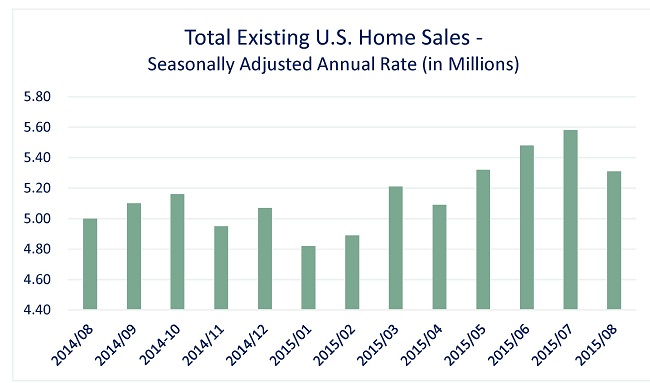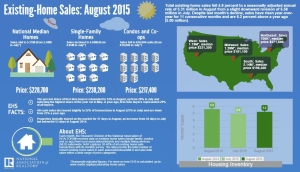It was a good run, but the string of 3 consecutive months of increasing existing home sales ended in August. Existing home sales dropped last month, putting a crimp in the market’s continued recovery.
Sales of existing homes were down 4.8% from July, from 5.58 million down to 5.31 million homes. Year-over-year sales, however, are still up 6.2% from last August. One reason sales dropped in August could be a result of the strong sales in previous months keeping the number of homes available for sale limited. The total housing inventory was down to 2.29 million existing homes for sale (5.2 months’ supply of unsold inventory), a drop from last August’s 2.33 million existing homes (5.6 months’ supply). However, last month’s inventory was still up 1.3% from July’s 2.24 million existing homes (4.9 months). Plus, who wants to move children into a new house right after school starts.

Data obtained from National Association of Realtors (NAR).
Properties that closed in August stayed on the market for a median of 47 days, an increase from the median 42 days on market in July but down from the 53 days on market in August 2014. Roughly 40% of existing homes for sale in August were on the market for less than a month, compared to 42% of existing homes for sale in July and 47% in June, which was the highest share of rapid sales since June 2013.
A limited supply of homes on the market may keep sales more subdued heading into the fall. Housing starts fell for the second consecutive month in August to 1.126 million total units (annualized pace). According to Dr. Lawrence Yun, Chief Economist of the National Association of Realtors (NAR), that pace is well below the 1.5 million annual units that is historically typical. Single-family home construction was at just 739,000 units (annualized pace) in August, which is much lower than the 1.2 million units Yun would consider normal. Multifamily construction was at 387,000 units (annualized pace), which is still slightly above the long-term average despite the recent decline in momentum.
While sales have slowed, home prices have continued to rise. August marked the 42nd straight month of year-over-year increases in home prices. Houses of all types reached a median of $228,700, up more than $10,000 from August 2014 when the median price was $218,400.
Other factors may be holding the housing market back from even larger sales gains in the coming months. The U.S. economy is doing relatively well, and in August the unemployment rate fell to 5.1%. That’s a level economists haven’t seen since 2008.
Although the American job market appears to be doing reasonably well, the low inventory of homes is causing some issues. Many metropolitan areas are seeing job openings outpace the number of available houses. The high housing demand and low supply is pushing prices up and causing a strain on workers who want to live close to their jobs.
A recent NAR study looked at the job creation rate versus the pace of housing starts in 146 metropolitan statistical areas (MSAs) from 2012 through 2014. The results showed that homebuilding had not kept pace with job growth in roughly two-thirds of the areas studied.
Historically, the ratio for the annual change in total workers to total building permits issued has averaged 1.2 for all housing types and 1.6 for single-family homes only. The NAR researchers found that through 2014, 63% of the MSAs studied had a ratio of more than 1.2 for all housing types, and 72% had a ratio over 1.6 for single-family homes. The higher than average ratios suggest that housing construction in the majority of metro areas across the country is lagging behind the number of jobs being created.
Not surprisingly, cities such as San José (22.6 single-family home ratio), San Francisco (22.4 single-family home ratio), San Diego (13.9 single-family home ratio), and New York (13.9 single-family home ratio) had some of the highest disparities in the NAR study between new jobs and newly constructed homes.
If developable land in metropolitan areas were abundant, then builders could alleviate some of the stress in those areas by focusing on building more single-family homes to keep the market in a more affordable state of growth. However, topography limits developable land in these areas, and regulations and costs have limited the amount of single-family construction in what little land is available.
How do you see the housing market doing the rest of this year? Leave your thoughts in the comments.






Recent Comments